by Dave Workman | Senior Editor
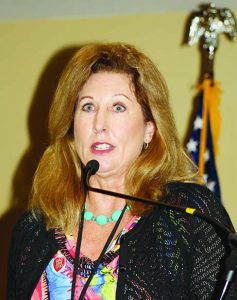
Sidney Powell.
The battle over Second Amendment rights versus the desires of the gun prohibition lobby is far from over, and various panelists speaking at the 2016 Gun Rights Policy Conference in Tampa the weekend of Sept. 23-25 made that abundantly clear.
Attorney Sidney Powell, author of Licensed to Lie: Exposing Corruption in the Department of Justice, told the audience that the Justice Department “has become a weapon” of the Obama administration, along with other agencies of the federal government. She accused the agency of “running roughshod over civil rights.”
Her pre-election advice was simple: elect people who will clean out every agency.
Powell touched on the case against the late Alaska Sen. Ted Stevens. Federal prosecutors withheld evidence that could have cleared him of charges that he accepted gifts without properly reporting them.
Stevens had been indicted back in 2008, before Obama was elected. But a whistleblower complaint resulted in an investigation that uncovered what a federal judge later called “the worst case of prosecutorial misconduct he’d ever seen,” according to a history of the events on Wikipedia.
Powell cautioned that the government will “often say they fixed things when things haven’t been fixed at all.”
The next panel detailed the Gun Rights Battle from a media perspective, with Herb Stupp from the Judicial Watch Writers Group telling the crowd that “the media is not necessarily the enemy, they’re just lazy.” He suggested that gun rights activists or groups become the “go to” people for local press when questions about the Second Amendment or firearms come up.
“Offer them a tour, have them visit your gun club,” he suggested.
The problem with media laziness is that they “just accept stuff” from gun control groups. One problem is manpower, which makes it difficult to do a complete story. He also advised people to watch news stories for errors and contact the newspaper or station to seek corrections.
Steven Gutowski with the Washington Free Beacon suggested providing stories to the media because they don’t seek such stories. The Free Beacon tries to break original stories, he explained, that are true and benefit the pro-gun point of view, including self-defense stories.
He said big newspapers do not have “gun beats” that cover firearms-related news, despite the fact that millions of people own guns. It is up to people to correct the “blind spot” that major media has ignored.
Gutowski also mentioned the controversy over Katie Couric’s controversial documentary “Under the Gun,” which is now the subject of a $12 million lawsuit. He broke the story that exposed problems with that program.
AWR Hawkins with Breitbart said the mainstream media are surrogates for the gun control movement. He said one of their most popular questions is about when “universal background checks” will become the law. He opposes such checks, because they put the government between citizens and their right to keep and bear arms.
“The background check is wrong because it doesn’t work,” he asserted.
Hawkins then went through a lengthy list of terrorists and killers who had passed background checks, including the Fort Hood shooter and the man who shot former Congresswoman Gabrielle Giffords. He criticized the press for seemingly supporting gun control, which he insisted is not the solution.
Radio host Mark Walters wrapped up the panel by asking the audience if they think they get a fair shake from the mainstream press. He said the mainstream media is the single most dangerous entity in the country because it drives a narrative of their choosing.
He criticized “news personalities” who make big money without caring whether they have been objective.
Walters said the way to combat media bias is to write letters and let the media know they are being watched.
“Don’t trust them, they hate you (and) they only care about their agenda,” he said.
Heller and McDonald
David T. Hardy, an attorney, author and historian gave a 15-minute dissertation on the Heller and McDonald Supreme Court cases, and what led to their being filed.
He recalled how a core of young attorneys began specializing in the kind of work that led to much Second Amendment research. They published in small law reviews, he said, and explained that the way to make an argument stand out is to publish in a major law review.
In 1976, the Second Amendment sponsored an academic conference on the Second Amendment, and ten years later, attorney and law professor Donald Kates published a piece in the Michigan Law Review that apparently influenced some major names in the legal academic profession. Ultimately, many of the “big names” began addressing the Second Amendment as an individual right, and people had to pay attention.
People began waking up, he said, with the 2003 Emerson decision in the US 5th Circuit Court of Appeals that said the Second Amendment protected an individual right.
Hardy described how the Heller case against the District of Columbia’s handgun ban took shape and how the high court handed down the historic ruling that struck down the ban.
He said there was really no coordinated strategy, but the efforts of many like-minded individuals who did the scholarly research and brought the evidence forward.
Hardy was immediately followed at the podium by Jim Irvine, president of the Buckeye Firearms Association, talking about an effort to reverse school disarmament. He developed the program in Ohio, where he pushed the FASTER program (for Faculty Administrator Safety Training in Emergency Response) program that was developed by a police officer and trainer named John Benner.
The key to stopping a school shooting is to train the faculty and staff, he suggested. Irvine said the Sandy Hook tragedy “opened the door for us.” While school administrators may not like guns, they love kids, he noted.
The course was created to educate school staffers. The first class offering brought at least 1,000 inquiries. Now the class runs for three days, with plenty of shooting and force-on-force training, and there are different levels that include first aid training.
Irvine said there have now been hundreds of people trained with the course.
Urban Outreach
Rick Ector, author of the “Legally Armed in Detroit” blog and founder of Rick’s Firearms Academy in Detroit, related his personal history of involvement in the Second Amendment movement.
He was robbed in his own yard. When he reported it to the police, he recalled they didn’t seem to care, so he applied for a concealed carry license, read everything he could about firearms safety and personal protection, joined the NRA and became a firearms instructor.
Ector reaches out to the urban community to push the importance of gun rights. He described it as a “fire” that had been ignited inside of him. As he became more involved in the gun rights movement, he became more politically aware.
He recalled former leadership in Detroit that disdained firearms and self-defense. He read Kenn Blanchard’s website “Black Man with a Gun.” And then he attended a Gun Rights conference in 2007 and nowadays he encourages people to be a resource for others.
This is important in larger American cities, which still have strict gun laws, anti-gun politicians and high crime rates, he explained. When he offered a free shooting class for women, he got 50 women to attend. This past July 31, he did a fifth annual event for women, and 417 women turned out. Many later bought firearms and holsters.
Fact versus Fiction
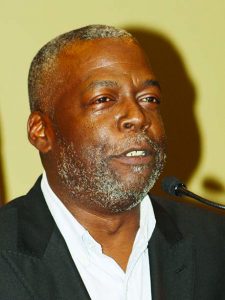
Rick Ector.
John Lott, president of the Crime Prevention Research Center, told the audience about separating fact from fiction. He explained that the two groups of people who benefit the most from owning guns are minorities living in inner cities and the elderly and weaker people; those who are most likely to be victimized by crime.
He lauded Ector’s activities in the inner city for teaching people how to defend themselves.
But Lott trained his sights on Democrat politicians representing urban areas. Their policies have disarmed the very people who could most benefit from gun ownership, Lott asserted. He used as an example the gun laws in Washington, DC, after the Heller ruling in 2008. It costs more than $800 to license and register a handgun now in that city, a financial impairment for anyone who is poor and living on a fixed income.
Lott then turned his attention to the Supreme Court.
“Right now,” he said, “you basically have a four-to-four tie, after Justice Scalia’s death earlier this year in terms of justices who believe there’s an individual right to self-defense and those who don’t. Whoever appoints Scalia’s replacement is going to determine the outcome of that and there’s cases that we’ve lost in places like California that look like they may be going to the Supreme Court and whoever appoints them is going to decide whether the Heller decision is overturned or not.”
Lott called the Heller decision “basic,” because it said that government could not simply ban guns. A reversal on Heller would allow renewal of handgun bans, he suggested.
He also took issue with gun control proponents, including President Obama, who have pushed gun laws that would not have prevented a single mass shooting, had they been in effect. Lott said reporters could easily challenge the president to name a single incident that would have been thwarted, adding, “He can’t.”
Lott asserted that many of the people who have been prohibited from buying guns are mistakes. This also affects minorities, who have names that are the same or similar to people who actually are prohibited, and this creates “false positives” during a background check.
He also raised questions about whether the United States has more mass shootings than any other country, and if the per capita death rate from such shootings is higher or much lower than for shootings in the rest of the world.
Lott further noted that some surveys showing increased gun ownership have gotten virtually no coverage from the news media. This is how the media creates the impression that gun owners are separate from the rest of society.
Obama’s Gun Medicine
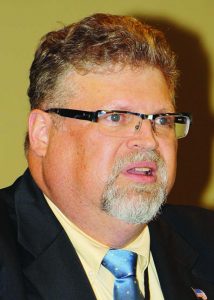
Dr. John Edeen.
Medical professionals took the stage next, explaining the problems with President Obama’s gun control “medicine.”
Dr. Sean Brodale, an emergency medicine physician, complained, “We all know there is no need for accuracy when promoting gun control.”
He alluded to studies by the medical establishment that twist the truth and tell “outright lies” about guns “in constant attempts to obliterate our rights to bear arms.” He ripped research that suggests gun ownership is a major risk factor in the home.
He also was critical of the medical establishment when it says that gun-related violence amounts to an epidemic or public health crisis in the country. Contending that 30,000 people die each year from “gun violence” is misleading, he said, because two-thirds of those fatalities are suicides.
“The medical establishment has taken up arms against our right to keep and bear arms,” he observed.
Dr. John Edeen from Texas described himself as a “fervent opponent of gun-free zones.” He was critical of the “culture among hospital administrators” against guns. Edeen also mentioned an article he published in 2015 about active shooter situations in hospitals.
“We are disarmed by both law and hospital policy,” he said. “Their policies actually attract the type of event that their plastic signs are supposed to prevent.”
He voiced concerns about terrorism in hospitals, calling the institutions “soft targets” and force multipliers if a terrorist attacks an emergency ward where victims of an attack would be taken for treatment.
Edeen would like to see legislation holding the owners of “gun-free zones” responsible for any injuries that happen in their facilities because of their anti-gun policies.
Dr. Robert B. Young, a Distinguished Fellow of the American Psychiatric Association, contended that the anti-gun officials at the Centers for Disease and Control want to ban handguns. He delivered something of a testimonial for Dr. Tim Wheeler, founder, with a handful of other physicians, of Doctors for Responsible Gun Ownership (DRGO) in 1993.
Young recalled how Wheeler’s arguments in support of gun ownership were routinely squelched, but he could not be completely silenced. He testified before Congress on guns, contributing to passage of an amendment that prevented the CDC from conducting anti-gun research.
Appropriately, Wheeler wrapped up the panel discussion, by first giving accolades to Marion Hammer, former NRA president whom he credited for being the driving force behind the Florida law that prevents doctors from discussing firearms ownership with their patients. Hammer is executive director of the Unified Sportsmen of Florida, but she could not attend the conference, Wheeler added.
“Because of Marion Hammer,” he said, “the medical establishment and not just in Florida but all across the United States, have been put on notice that they cannot abuse a patient’s trust in their doctor to push a political agenda of gun control in the exam room.”
Wheeler announced that he is going to back away from the day-to-day operation of DRGO, but he will continue to be part of the fight. He said the group is going to develop a referral service to physicians and health care providers who are pro-Second Amendment.
DRGO is now a project of the Second Amendment Foundation.
Update on DC Project
Cheryl Todd, co-host of Gun Freedom Radio, and Clover Lawson told the audience about the DC project, a grassroots group that brings 50 women, one from each state, to Washington, DC, to meet with their respective lawmakers about firearms and personal protection. It is a non-partisan effort that highlights the diversity of gun owners and the growing number of women who own firearms.
The group encourages gun ownership for a variety of reasons including competitive sports, self-defense and hunting, according to their website.
The first effort brought 35 women to the Capitol and they held a rally on the west lawn of the Capitol building, according to Todd.
The effort was launched by Dianna Muller, who encouraged female gun owners to meet with lawmakers in an effort to show that not all women support the gun control agenda.
Participants in the effort paid their own way, took time off work and away from their families, Todd recalled. The group included liberal female gun owners, she added.
Lawson even visited the office of a congressman from Florida who is anti-gun. She was accompanied by another activist, and they provided information on shooting and gun ownership.
She noted that if a meeting only with staff is possible, it is still a valuable connection.
Todd stressed that the participants were not lobbyists, but citizens who traveled to meet with lawmakers.
State Coalitions
The next panel discussed building state coalitions. Tom Bolioli with the Commonwealth Second Amendment group from Massachusetts cautioned the audience against creating an organization without first learning whether an existing group already does what you want to do, or an existing group could be approached to do something it isn’t presently doing.
It is better to determine if there is a niche that is not being filled, he stressed. To create a new group that does the same thing as an existing group does, “you are diluting your power,” he said.
Bolioli reminded the audience that the Massachusetts attorney general had recently declared that all semi-auto firearms that had been purchased legally over the past two decades were suddenly illegal guns. He said Massachusetts gun owners are in the fight of their lives, and that all the state gun groups are working together to fight her.
“You need to work together,” he said.
Likewise, Richard Nascak, founder and co-executive director of Florida Carry, Inc., told the audience that, “even if you disagree with other organizations, you have to work with them.”
He discussed the history of his group, which was founded in 2010 and incorporated the following year. In 2012, Florida Carry participated in the Gun Rights Conference, and Nascak declared, “We’re here to stay.”
Nascak stressed the importance of commitment to the issue, and he also said such groups must identify their friends and their enemies.
John Cushman, an NRA director for some 20 years and president of the Sportsmen’s Association for Firearms Education (SAFE) in New York, offered important tips on how to run a grassroots organization. One critical task is to monitor legislation in various state legislatures, so that activists can be kept appraised of any developments.
Another task is to write letters, and to that end, he suggested sending letters in self-addressed envelopes so that the recipient lawmaker understands that the letter comes from an individual, not some group.
Keep it simple when writing letters, he added. Letters should be limited to one page and focus only a couple of items.
Gene Hoffman, president of the CalGuns Foundation, concurred with the other speakers that activists should not create a new organization without first looking to see what groups already exist and “who is doing the work” and if you can be part of that work.
“If you have the time and the effort to invest, you should do your part,” he said.
Using ‘Old Media’
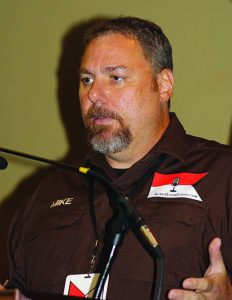
Mike Piwowarski
Advancing gun rights by using “old media” is still an effective strategy, according to the next panel.
Charles Heller, host of Liberty Watch Radio in Tucson, AZ, noted that when people approach someone in the media, they are looking for attention. As a radio host, he habitually tries to determine if someone approaching him for a story has something to gain.
One of his efforts is the “DIE” initiative (for “Don’t Inspire Evil”). This effort is aimed at reducing the potential for copycats who might be inspired to act because someone else got publicity for committing a crime. He hopes to establish the DIE as a standard for broadcasters.
“Here’s something positive you can do as an individual or a group,” he suggested.
Mike Piwowarski, host of Arms Room Radio, said “old media still has a great purpose.” While acknowledging that the Internet and Twitter, and other social media are valuable, he pointed to weekly newspapers as one avenue to get a pro-gun message out. His advice is to call one’s self “pro-rights.”
“Write about something you know,” he urged. “Don’t write in response to something. Do something original.”
There are “plenty of resources” to support anything written from a pro-Second Amendment perspective, and he said it “gets the message out there.” It is also important to write about something that concurs with the position of gun rights organizations.
This is how someone builds a personal resume of authority regarding the subject matter.
Lee Williams, senior investigative journalist with the Sarasota Herald Tribune, has a pro-gun blog that is fully supported and funded by the newspaper. A former law enforcement professional, he started his blog just a few weeks after the Sandy Hook tragedy.
His blog has been awarded by professional journalists, and it has expanded to include a weekly opinion column in the print version of the newspaper.
“You can still work with the mainstream media. You just have to be very careful,” he said.
He counseled people to educate reporters, find some they can work with and move forward.
Using ‘New Media’
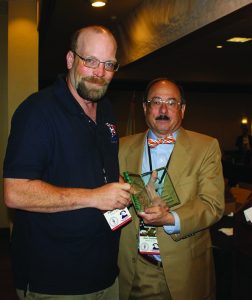
Paul Lathrop (left) receives the first annual award for excellence in social media, named for the late Ray Carter, an SAF staffer, from Alan M. Gottlieb.
The discussion went swiftly from old media to new media to advance gun rights. Don Irvine, chairman of Accuracy in Media, told the audience that various new social mediums including Facebook and Twitter, are valuable when trying to advance gun rights. He said Facebook Live is a vital medium that allows people to stream things live to an audience as they happen.
Those videos remain in a library essentially forever, Irvine noted.
He cautioned people to behave themselves on social media, particularly Twitter. And use facts. That’s what he said “kills the other side.”
Charles Cook, host of “Riding Shotgun with Charlie” on YouTube, discussed his experience with social media. A Massachusetts resident, he is a musician and band teacher, and spent the last ten years as a firearms instructor.
He does videos with music punctuated with the sound of gunfire. He has about 50 videos on YouTube with this feature. They have quite a following, and they introduce a lot of people to firearms and gun owners as regular people.
Paul Lathrop, host and owner of the Polite Society podcast, said gun owners can lead by example. The podcast is on the Self Defense radio network. He said every person on the show fights for freedom outside the show.
By encouraging (people) to get involved,” he said, “we help to swing the scales.”
By putting his thoughts forward on social media, he hoped to help change peoples’ attitudes. Podcasts are popular with people, and 21 percent of American adults frequently listen to podcasts.
He referred to polls that say 44 percent of Americans admit to owning firearms. He estimated that this amounts to more than 144 million people. Lathrop said he reaches about 25,000 people a month and that’s how he tries to make a difference.
John Richardson, author at No Lawyers, Only Guns and Money, said gun owners are in a political and cultural war to save gun rights. He added that gun owners are “facing an unholy alliance of academia, left wing politicians, big media and so-called gun safety groups.” He said the gun control lobby is savvy, smart and they try to marginalize gun owners as uneducated white rednecks who are not mainstream America.
But gun owners can wage an effective guerilla war using new media. He rattled off several different social media and recommended that everyone learn how to use one or two of these to push positive information about guns and related activities. This “normalizes” gun owners and shooting.
By taking guests to the gun range, “you inoculate them against the lies of anti-gunners,” he said.
Andrew Gottlieb, director of development for the Second Amendment Foundation, wrapped up the discussion by noting that 60 percent of millennials support gun rights, contrary to what the mainstream media suggests. He said sharing information about firearms brings more people into the fold.
He called out former House Speaker Nancy Pelosi for falsely claiming there had been more than 272 mass shootings in this country.
“The beauty of new media is, it’s our media,” he said. ‘If you share a topic (on Facebook), you can get something trending.”
A Sheriff Speaks
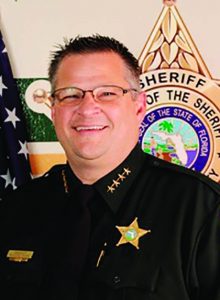
Brevard County, FL, Sheriff Wayne Ivey.
Brevard County, FL, Sheriff Wayne Ivey provided some chuckles and no small amount of common sense when he took the podium to explain his philosophy and a program that offers training to armed citizens.
“If you are a citizen that has a concealed carry (license), carry your gun with you to every potential venue that you can,” he said. “Be prepared to protect yourself.”
“Everybody in here better have a gun,” he quipped. “We have a strong understanding that if you’re a good person and you come into Brevard County and you don’t have a gun, we issue you one.”
The 37-year law enforcement veteran called himself a “constitutional sheriff” and declared that the Second Amendment is under attack. He told the audience that he wants a “balanced Supreme Court that will protect our cops, citizens and Constitution.”
Sheriff Ivey, an advocate of armed citizens, said the best way he can protect people is to prepare them to protect themselves. His agency offers a course on “Self-defense through tactical shooting and decision making.”
He said the government’s only responsibility is to protect its citizens. The country doesn’t need gun control because it already had gun control, he added. What the country lacks is criminal control by keeping lawbreakers locked up so they cannot hurt people.
“You are the first line of defense,” he added. “If you look at San Bernardino from the time the first call was made to the time police arrived on the scene was four minutes. You’re the first line. You are the person that is going to have the best chance of saving your life, your families’ life and all the people around you.”
Writers Advancing Freedom
The next panel consisted of writers and authors who discussed how they promote firearms freedom through writing.
Raquel Okyay, a writer for Human Events, told the audience to “get the word out that guns are something good.” She described gun rights as something that exists without government.
Firearms owners are “regular people” who get penalized by the media for the fact that they own guns, she explained. Her articles about gun rights have been “published all over the place” and she has also written a popular blog.
Okyay criticized the New York SAFE Act, a gun control “monstrosity.” Her articles have gotten wide attention thanks to social media.
Chris Bird, author of the newly-released Surviving a Mass Killer Rampage, gave a bit of history about his writing career. He did a book several years ago titled the Concealed Handgun Manual that has gone through several updates.
He hails from a country that “basically disarmed its citizens.” After leaving Britain, he became a journalist and newspaper writer in Canada. Bird said the best way to get a message across to the public is to tell stories. The feedback was positive, and he did another book titled Thank God I Had A Gun, which told stories about people using firearms in self-defense.
Bird had discussed self-defense with some different sheriffs, who stressed the importance of carrying defensive firearms if they have a license to carry. In general, he said sheriffs are typically more supportive of concealed carry than police chiefs.
Massad Ayoob, author of several self-defense related books and magazine articles, noted that his grandfather was in a gunfight with some bad guys and prevailed. His father also engaged in an armed confrontation. Ayoob began working in a jewelry shop at age 12 and there were firearms in the store. At that time, there was no literature on when it is acceptable to use lethal force, and that ultimately led to his authorship of In the Gravest Extreme in 1980.
“All of us have the duty to spread to the gun owning community what the rules are,” he said.
He stressed the importance of calling the police if you are involved in a shooting incident. He advised people to consider defensive firearms as “safety rescue tools.”
Dave Workman, senior editor at TGM, described his role as “the balance” in journalism. He has found that writing fact-based material that relies on his knowledge of firearms and how they work provides an opportunity to provide details and “the other side of the story” about firearms.
LGBT Gun Rights
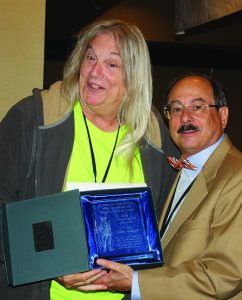
Alan M. Gottlieb (right) presents the Grasroots Activist of the Year Award to Nikki Stallard of the Pink Pistols at the 2016 GRPC Awards Luncheon.
Expanding gun rights in the LGBT community brought two panelists to the podium. Nicole Stallard with the California Pink Pistols explained the program. The message is “Armed Gays don’t get Bashed.”
Stallard said that firearms is “not a left/right thing, it’s a human rights thing.” She said the firearms community has stepped up since the massacre in Orlando, and Pink Pistols membership has grown more than 500 percent in the aftermath.
The Pulse attack “has really brought Americans together,” Stallard said. Groups have come together and even Donald Trump and NRA’s Chris Cox made it clear that gun rights extend to everyone.
Chad Hendrix with the Florida Pink Pistols vowed to join Florida Carry, and recalled how he had been a reserve deputy sheriff when he graduated from college. He became a firearms instructor in 1992 and said his friends refer to him as “the rainbow Republican.”
He had been at the Pulse nightclub in Orlando a week before the terror attack. He criticized gun laws that disarm people in certain venues.
“We need to eliminate as many gun-free zones as we can,” he said.
He also noted that one person can make a difference. When he was asked by a reporter, “What do you want to do, carry guns in bars?” his reply was “Hell, yes, I want to carry a gun in a bar.”
Silencers
Todd Rathner, chairman of the NFA Freedom Alliance and an NRA director, explained what the NFA group is all about. These are gun owners who own suppressors and different firearms regulated by the National Firearms Act.
He said suppressors are one of the fastest expanding segments of the firearms industry today. Recalling how concealed carry was discussed and advanced in Florida, the same kind of process might apply to expanding the use of silencers
Many people do not know anything about NFA firearms and accessories, he said. He said the law was ill conceived.
He hopes to go across the country and fix problems with NFA weapons, while the ultimate goal is to repeal the NFA altogether.
Hunting with suppressors is legal in several states, and that will help normalize the use of suppressors. He mentioned several states that the NFA group has worked in, including Montana, Utah and Oklahoma.
Rathner suggested meeting lawmakers at the state and local level because often these people go on to higher office.
“They get it…because we educate them,” he said.
Guns and the election
Wrapping up this year’s conference, Richard Feldman, president of the Independent Firearms Owners Association, told the audience that “elections are always numbers games.” He said there are 291 million eligible voters but only 146 million are registered voters and then there are actual voters, numbering 126 million people. That’s roughly 60 percent of all actual voters.
This translates to about 30 percent of the voters deciding who the election winners are. This allows election victories by plurality.
Money is the key, but at the end of the day, money doesn’t vote, people vote, he said.
“That’s our secret,” he observed.
He said that no matter who wins the election, the fight will go on and “we will never, ever give up.”
Dennis Fusaro, president of Grassroots Solutions, told people that they can be involved as activists and have a big impact. The state and local level politicians are “the farm team,” he explained.
Take time to learn how campaigns work, he said. Support state and local candidates and show them that you can help them in their campaigns. Don’t become their captives but be the person who represents the gun issue to them, not them to the gun issue. Be the “go-to” person in the campaign about the firearms issue.
CCRKBA Chairman Alan Gottlieb closed the conference by telling the audience “Ready, Aim, Vote.” He said there was a databank of some 800,000 gun owners in California, but 300,000 of them were not registered to vote. Two years ago in Washington State, he found hundreds of thousands of gun owners who were also not registered to vote.
By now, the election is history, but the fight will go on.



